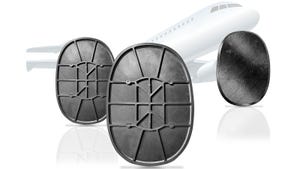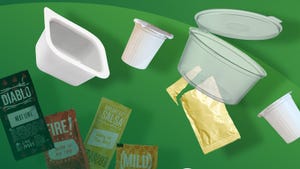K '98: Materials and Design News
January 4, 1999
Absorbing all of the news in material and design trends from the world's largest plastics trade show can be a tall order. Luckily, supplier offerings tended to follow several clear trends: large automotive body panels, application-specific grades, and globally uniform colorant systems. Again, plastics is pushing the envelope.
|
Figure 1. A sterling example of the future for automotive plastics, the VW Beetle (shown here at the Bayer stand) includes plastics supplied by Bayer for molded body trim, underhood components, and various interior parts. |
Resins Make the Body Beautiful
Most notable of the new application areas could be found in neat-resin body panels for automotive exteriors, formerly a metals-or-composites-only zone. As unfilled plastic fascias and door panels began to evolve, it was almost inevitable that other body parts would follow. At K'95, GE Plastics and BASF announced a joint development effort to advance materials technology for molded-in-color panels for the Smart Car. This year, most major resin suppliers touted their successes in developing large plastic exterior parts for various vehicles, including Smart, Ford Focus, VW Beetle (Figure 1), and some Mercedes models. In all cases, these successes come from collaborative efforts between resin suppliers, machinery manufacturers, molders, moldmakers, and OEMs. This is a trend we've seen before. As plastics begin to penetrate more sophisticated applications, it becomes essential that the materials and design technology evolve in tandem with machinery, tooling, and processing.
|
Figure 2. An exploded view of the MCC Smart Car, courtesy of Dynamit Nobel, shows the steel spaceframe surrounded by nine PC/PBT panels: right and left front fenders, center front, doors, right and left rear fenders, tailgate, and center back. All are molded-in-color, clearcoated with PU in an offline process, then partially preassembled before being delivered to the Smart assembly line. |
Now available in Europe, the Smart Car from MCC (Micro Compact Car) contains nine injection molded body panels (Figure 2) and was displayed prominently at the show in machinery and material supplier stands alike.
The orchestrated effort to develop panels for Smart, as it is now called, required all of the players-MCC, GE Plastics, BASF, Krauss-Maffei, and Dynamit Nobel, the molder and moldmaker-to participate from the concept stage through production. The team helped design and produce nine panels in PC/PBT (a proprietary, unfilled Xenoy grade). These panels (Figure 3) can be removed and replaced with those of a different color in 90 minutes, an idea that appeals to consumers' changing tastes, according to marketing info. In addition to colorant technology, BASF collaborated on a paint-free molding process for the roof (along with partners Senoplast, Engel, and Rohm). Krauss-Maffei contributed a customized plasticizing unit, modifying screw design and backflow nozzles.
| Figure 3. Dynamit Nobel showcased its production of Smart Car panels, molded in "smartville," a.k.a. the company's Hambach, France facility. Center front and fender panels shown here can be produced in a wide range of colors. |
Two days before K opened, Dynamit Nobel received SPE International's Grand Award for production and development of the "customized body panel system" for Smart.
More examples of large automotive applications peppered the stands of major resin suppliers:
Montell recently completed work on a thin-wall (2.6 mm) TPO bumper for Ford's Focus (successor to Mondeo) based on technology developed by both companies for the 2.5-mm Windstar fascia. The Focus fascia is molded in Hifax HSBM CB1158G by Ford Saarlouis in Germany.
Bayer showcased its hybrid metal/plastic front end (Figure 4) for the Ford Focus, a collaborative effort with molder Dynamit Nobel and toolmaker Misslbeck using glass-filled nylon 6 (Durethan BKV 30) and profiled steel plate. In this process, perforated steel inserts are placed in the mold prior to plastic injection, producing the part without the need for adhesives. The company also presented a concept for molding fascia, sealing gasket, and PC lens window in one shot, a joint effort with Battenfeld.
BASF announced it will soon launch a new version of PC/PBT under the Ultradur name as a result of its work with GE on Smart Car panels. This resin, featuring 20 percent lower thermal expansion, will be added to BASF's current offerings-Ultramid (nylon/PPE) and Luran (PC/ASA)-for automotive exteriors.
|
Figure 4. Structural stiffness for a car frame comes in the form of this hybrid plastic/steel front end for the Ford Focus. Molder Dynamit Nobel worked with toolmaker Misslbeck and resin supplier Bayer to insert-mold a 30 percent glass-filled nylon 6 (Durethan BKV30) onto profiled steel plates. The resulting frame is 40 percent lighter than all-metal versions. |
Material Improvements
Although material suppliers exhibiting at K offered up few breakthroughs, they did focus heavily on new application-specific grades along with upgrades to existing resins. In addition, three totally new materials for injection molding were announced: PCHE (polycyclohexylethylene) from Dow Plastics, a potential new resin for DVDs; Corterra PTT (polytrimethylene terephthalate) for automotive electronics from Shell Chemical; and biodegradable BAK (polyester amide) from Bayer. Injection molding grades for both Corterra and PCHE are still under development. BAK is a semicrystalline resin suitable for horticultural products and disposable utensils.
Modified grades were either application-specific or targeted at worldwide manufacturers, as the following highlights confirm:
BASF introduced a Terluran ABS world grade that is significantly whiter than other grades. Ken Baraw, applications development manager, explains that colorability and consistency were the main goals for the new grade. "This material will allow for richer, clearer colors and high gloss while helping to keep color tolerances tight," he says. "Also, high quality standards will ensure consistency in processing to greatly reduce or eliminate black speck problems." Baraw notes that the new grade is being run successfully in existing molds. It is offered in three injection molding grades and two high-heat IM grades. The material, formerly Terluran 800 and 900 series, was sold only in Europe until recently. Production is underway at BASF Korea and will also take place in Altamira, Mexico in April.
AlliedSignal introduced Capron HET, a new grade of nylon 6/6, for extreme environments that require temperature spike protection above 200C and hydrolysis resistance. Target applications are underhood engine components (Figure 5). The company also announced Infinity resin, a nylon 6 based on post-consumer recyclate. Rather than simply recycling, however, Allied developed a patented depolymerization process with DSM Chemicals. It converts the polyamide back to its original caprolactam monomer, which is then repolymerized to produce virgin quality nylon 6.
|
|
Figure 5. New grades around the globe are targeted at specific applications. For example, AlliedSignal's new Capron HET (nylon 6/6) was developed to resist conditions underhood for parts such as this Audi rocker cover. | Figure 6. Wear resistance and natural lubricity were the reasons Lexmark designers recently chose Carilon aliphatic PKs for 30 mm gears in the Optra S laser printer. Other applications for the material from Shell Chemical include automotive fuel systems and underhood components. |
RTP Co. will begin offering compounds based on Shell Chemicals' Carilon worldwide, thanks to a manufacturing facility in Beaune, France. The material, an aliphatic polyketone (PK), appears to be gaining ground in automotive fuel system and under-hood applications because it resists a broad range of fuels and fluids. An onboard refueling vapor recovery valve molded by GT Products was one of several recent examples on display in the Shell stand. In addition, PK offers wear resistance in gear applications, such as the gears for Lexmark's Optra S laser printer (Figure 6).
GE Plastics introduced several new Noryl (modified PPO) grades that make it possible to blend the resin with materials that could not be blended previously, such as styrenic block copolymers and SEBS. The so-called functionalized Noryl is aimed at business machine applications such as printers and fax machines. Now that GE has added colorability to its Xenoy resin, the company foresees non-automotive large part applications arising (Figure 7).
Trexel announced injection molding capabilities for a relatively new foaming process that uses carbon dioxide or nitrogen in place of toxic and flammable blowing agents. Formerly available only for extrusion, the process uniformly distributes cells and limits their size to 5 to 50 microns in diameter. Based on a microcellular foam technology invented at MIT, the MuCell process can be used on PS, PP, PC/ABS, nylon, and TPEs. According to the company, it may be a replacement for certain gas assist applications and requires some adaptation to existing presses. Users license the process directly from Trexel, who is currently working with Engel on the equipment end.
|
Figure 7. Now that colorability is an everyday occurrence for GE's Xenoy PC/PBT, thanks to development work for Smart Car panels, the company envisions other large-part applications such as the exterior for this conceptual refrigerator. |
World Colors
Global consumer products may be sold under different trade names, but manufacturers want to standardize the packaging colors so they are the exact same the world over. According to M.A. Hanna Color's Alan Burgess, manager of new product commercialization, that was the challenge posed by Reckitt & Colman, maker of French's mustard. "Colors had to be exact in shade and hue among a variety of plastic containers and closures using different resins," Burgess says. In this case, several color concentrates were developed to clear these hurdles.
Manufacturers are so committed to protecting their color "brand" they are seeking to standardize their signature colors. For example, Hanna is working with Proctor & Gamble on standardizing "Pantene" white, "Pert" green, and "Downy" blue, specific colors for high-profile products. Another issue for global manufacturers and color, according to Burgess, is the need for multiple capabilities so they can move molds and buy different resins as business dictates. P&G, for example, buys resin and produces locally, but ships color concentrate to these sites.
At Clariant, the emphasis was on color trends for the 21st century. The company partnered with International Color Authority and Merck to produce the first forecast of colors dedicated to plastics with over 80 colors and special effects pigments discussed in terms of six industry sectors. They also presented new materbatches with metallic special effects specifically for ski boots and bindings and a new series of sanitized additives for antimicrobial protection.
You May Also Like









